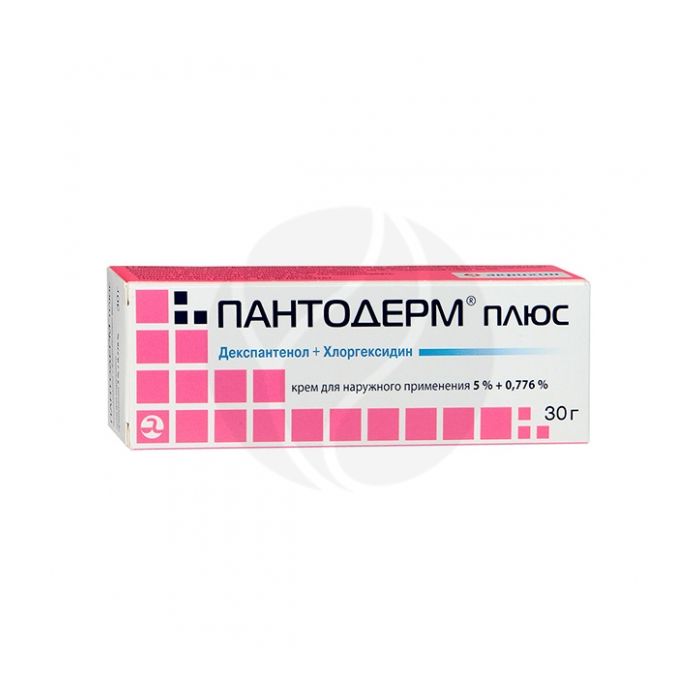Pantoderm Plus cream for external use 5%, 30 g
Russian Pharmacy name:
Пантодерм Плюс крем для наружного применения 5%, 30 г
Small wounds with a threat of infection (abrasions, scratches, small cuts and scratches, cracks, minor burns);
infected superficial skin lesions;
cracked nipples during breastfeeding;
chronic wounds (for example, leg ulcers, bedsores);
operating wounds.
The method of application and dosage regimen of a particular drug depends on its form of release and other factors. The optimal dosage regimen is determined by the doctor. It is necessary to strictly observe the compliance of the used dosage form of a particular drug with the indications for use and the dosage regimen.
Applied externally 1 or several times / day, applied to a previously cleansed wound surface or to inflamed skin areas. Treatment of wounds can be carried out both openly and using bandages.
Active substance:
dexpanthenol - 5 g
chlorhexidine bigluconate - 0.076 g
Excipients: propylene glycol - 9 g, squalane - 3 mg, liquid paraffin - 14 g, soft white paraffin - 5 g, dimethicone - 1 g, cetostearyl alcohol (cetyl alcohol - 60%, stearyl alcohol - 40%) - 6.7 mg, macrogol cetostearate - 2.3 g, pantolactone - 0.5 g, purified water - up to 100 g.
For the treatment or treatment of the auricle;
in the case of severe, deep and heavily contaminated wounds (such injuries require medical attention);
hypersensitivity to dexpanthenol and / or chlorhexidine.
Clinical and pharmacological group: A drug that improves trophism and tissue regeneration, for external use
Pharmaco-therapeutic group: Tissue regeneration stimulant
pharmachologic effect
Combined drug for external use. Has antimicrobial, anti-inflammatory effect: improves tissue regeneration.
Dexpanthenol in skin cells is rapidly converted to pantothenic acid, which plays an important role in both the formation and healing of damaged skin.
Chlorhexidine is an antiseptic, active against vegetative forms of gram-negative and gram-positive bacteria, as well as yeast, dermatophytes and lipophilic viruses. It acts on bacterial spores only at elevated temperatures. Cleans and disinfects the skin without causing damage. When applied to the wound surface, protects against infection, promoting healing.
Indications
Small wounds with a threat of infection (abrasions, scratches, small cuts and scratches, cracks, minor burns);
infected superficial skin lesions;
cracked nipples during breastfeeding;
chronic wounds (for example, leg ulcers, bedsores);
operating wounds.
Dosage regimen
The method of application and dosage regimen of a particular drug depends on its form of release and other factors. The optimal dosage regimen is determined by the doctor. It is necessary to strictly observe the compliance of the used dosage form of a particular drug with the indications for use and the dosage regimen.
Applied externally 1 or several times / day, applied to a previously cleansed wound surface or to inflamed skin areas. Treatment of wounds can be carried out both openly and using bandages.
Side effect
Allergic reactions: urticaria, itching are possible.
Contraindications for use
For the treatment or treatment of the auricle;
in the case of severe, deep and heavily contaminated wounds (such injuries require medical attention);
hypersensitivity to dexpanthenol and / or chlorhexidine.
Application during pregnancy and lactation
Can be used during pregnancy and during breastfeeding, but should be avoided on large skin surfaces.
Use in elderly patients
The drug is approved for use in elderly patients
special instructions
Avoid contact with the eyes of preparations containing dexpanthenol / chlorhexidine.
Cannot be taken internally.
Large lesions, heavily contaminated and deep wounds, as well as bitten and puncture wounds require medical attention (due to the risk of tetanus).
If the size of the wound remains invariably large for some time or the wound does not heal within 10-14 days, then a doctor's consultation is necessary. This is also necessary if the edges of the wound are severely hyperemic, the wound suddenly swells, severe pain appears, or the damage is accompanied by fever (due to the risk of sepsis).
Drug interactions
As a precaution against possible interactions (antagonism or inactivation), this combination should not be used concurrently with other antiseptics.

